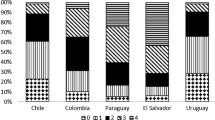Abstract
The share of income going to the poorest 10% of Americans is much smaller than the share of income going to the poorest 10% of Canadians, Swedes, or Germans (before unification). However, comparisons across countries of the distribution of housing conditions, consumer durables, health, and visits to the doctor and dentist suggest that compared to the average person in their country, low-income Americans are no worse off than low-income residents of other countries. But these conclusions partly depend on how income is adjusted for family size. Americans whose incomes are low for a long time may suffer more material deprivation than Canadians whose incomes are low for a long time. Conclusions about economic well-being based on current income may not rank nations the same as comparisons based on deprivation in living conditions.
Similar content being viewed by others
References
Coder J (1991) Exploring nonsampling errors in the wage and salary income data from the March Current Population Survey. Housing and Household Economic Statistics Division, US Bureau of the Census, Washington, DC.
Coleman RP, Rainwater L (1978) Social standing in America. Basic Books, New York.
Duncan G, Gustafsson B, Hauser R, Hausman P, Jenkins S, Messinger H, Muffels R, Nolan B, Ray JC, Voges W (1992) Poverty and social assistance dynamics in the United States, Canada, and Europe. Paper presented at the Joint Center for Political and Economic Studies, Washington, DC.
Engel E (1885) Die Lebenskosten belgischer Arbeiterfamilien früher und jetzt. Int Statist Institute Bull 9:1–74.
Erikson R, Aberg R (1987) Welfare in transition: a survey of living conditions in Sweden 1968–1981. Clarendon Press, Oxford.
Eurostat (1988) Family budgets: comparative tables. Luxembourg.
Glatzer W (1987) Living conditions and their assessment. Soc Indic Res 19:39–46.
Institutet for Social Forskning (1984) Variabler och kodr for LNU81. Stockholm.
Lazear EP, Michael RT (1980) Family size and the distribution of real per capita income. Am Econ Rev 70:91–107.
Mayer SE (1992a) Are there economic barriers to visiting the doctor? Harris School of Public Policy Studies Working Paper 92-6, University of Chicago.
Mayer SE (1992b) A Comparison of poverty and living conditions in the US, Sweden, Canada and Germany. Harris School of Public Policy Studies Working Paper 92-3, University of Chicago.
Mayer SE, Jencks CS (1989) Poverty and distribution of material hardship. J Human Resources 24 (1):88–1140.
Mayer SE, Jencks CS (1993) Recent trends in economic inequality in the United States: income vs. expenditure vs. material well-being. In: Popadimitriou D, Wolff E (eds) Poverty and prosperity in America at the close of the Twentieth Century. St. Martin Press, New York.
OECD (1990) Main economic indicators. Paris.
Palmer JL, Smeeding TM, Jencks C (1988) The uses and limits of income comparisons. In: Palmer JL, Smeeding TM, Torrey BB (eds) The vulnerable. Urban Institute Press, Washington, DC.
Rainwater L (1974) What money buys: inequality and the social meaning of money. Basic books, New York.
Rainwater L (1991) Poverty in American eyes. Department of Sociology, Harvard University (unpublished manuscript).
Ringen S (1987) Poverty in the welfare state? In: Erikson R, Hansen EJ, Ringen S, Uusitalo H (eds) The Scandinavian model. M. E. Sharpe, New York.
Smeeding TM, Torrey BB, Rein M (1988) Patterns of income and poverty: the economic status of children and the elderly in eight countries. In: Palmer JL, Smeeding TM, Torrey BB (eds) The vulnerable. Urban Institute Press, Washington, DC.
Statistics Canada (1981) The health of Canadians: report of the Canadian health survey. Minister of Supply and Services, Ottawa, Canada.
Townsend P (1979) Poverty in the United Kingdom: a survey of household resources and standards of living. University of California Press, Los Angeles.
Travers P, Richardson S (1989) Averages and tails: the tenuous link between poverty status and standard of living. Working Paper ≠ 89–3, Department of Economics, University of Adelaide, Australia.
US Bureau of the Census (1987) Statistical abstract of the United States: 1987. (107th Edition). US Government Printing Office, Washington, DC.
US Bureau of the Census (1991) Statistical abstract of the United States: 1991. (111th Edition). US Government Printing Office, Washington, DC.
Universität Frankfurt am Main (1988) Das Sozio-ökonomische Panel. Sonderforschungsbereich 3 (Mikroanalytische Grundlagen der Gesellschaftspolitik). Frankfurt am Main, Germany.
Van der Gaag J, Smolensky E (1981) True household equivalence scales and characteristics of the poor in the United States. Rev Income Wealth 28 (1):17–28.
Vaughn D (1984) Using subjective assessments of income to estimate family equivalence scales: a report of work in progress. Social Security Administration. Offset, Washington, DC.
Author information
Authors and Affiliations
Additional information
The Joint Center for Political and Economic Studies, The Russell Sage Foundation, the National Science Foundation and a Small Grant from the Institute for Research on Poverty provided funding for various stages of this project. I am indebted to Christopher Jencks and two anonymous reviewers for comments on an earlier draft of this paper. I am also indebted to Larry Radbill who provided computer programing for the United States and Swedish data and valuable technical suggestions. Monica Ardelt provided computer programing and technical assistance for the German data. Johan Fritzel provided technical assistance for the Swedish data and David Rhodes, Karen Rolf, and Tim Veenstra provided computer programing for the Unites States data.
Rights and permissions
About this article
Cite this article
Mayer, S.E. Living conditions among the poor in four rich countries. J Popul Econ 6, 261–286 (1993). https://doi.org/10.1007/BF00163070
Received:
Accepted:
Issue Date:
DOI: https://doi.org/10.1007/BF00163070




